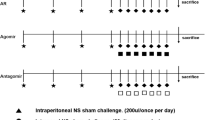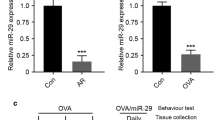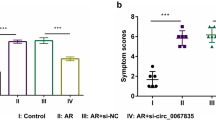Abstract
Allergic rhinitis (AR) is a common hypersensitive disease that troubles patients a lot. Nasal epithelial cells (NECs), as the outmost protection of inhalation, play an important role in AR allergic response. Adrenoceptor beta 2 (ADRB2) is an important gene in inflammatory response, which has become the hot spot for AR development and treatment in recent years. MiR-15a-5p has been proved to be involved in AR immune response as the upstream regulator of ADRB2. Human primary NECs were isolated and stimulated by IL-13. qRT-PCR assay was used to detect the RNA level of target genes. ELISA and Western blotting were applied to detect target protein levels. Luciferase reporter assay and biotin pull-down assay were performed to test molecules interaction. ADRB2 was highly expressed in nasal mucosa of AR patients and was positively correlated with IL-13 stimulation, and knockdown of ADRB2 inhibited IL-13-induced expression of GM-CSF, eotaxin, and MUC5AC in NECs. ADRB2 was directly targeted by miR-15a-5p, and miR-15a-5p inhibited IL-13-induced expression of GM-CSF, eotaxin, and MUC5AC in NECs. ADRB2 mediated the effect of miR-15a-5p on the regulation of nasal epithelial immune responses. ADRB2 is negatively regulated by miR-15a-5p, which inhibits IL-13-induced nasal epithelial inflammatory responses.





Similar content being viewed by others
References
Rosati MG, Peters AT. Relationships among allergic rhinitis, asthma, and chronic rhinosinusitis. Am J Rhinol Allergy. 2016;30(1):44–7.
Scadding G. Cytokine profiles in allergic rhinitis. Curr Allergy Asthma Rep. 2014;14(5):435.
Bousquet J, Khaltaev N, Cruz AA, Denburg J, Fokkens WJ, Togias A, et al. Allergic rhinitis and its impact on asthma (ARIA) 2008 update (in collaboration with the World Health Organization, GA(2)LEN and AllerGen). Allergy. 2008;63:8.
Ro EJ, Cha PH, Kim HY, Cho YH, Park JW, Han JS, et al. House dust mite allergen Der f 2 induces interleukin-13 expression by activating the PI3K/Akt pathway. Immunol Res. 2013;56(1):181–8.
Shi JB, Luo Q, Chen FH, Chen DH, Xu G, Li HB. Induction of IL-6 and IL-8 by house dust mite allergen Der p1 in cultured human nasal epithelial cells is associated with PAR/PI3K/NF kappa B signaling. ORL J Oto-Rhino-Laryngol. 2010;72(5):256–65.
Shimizu S, Kouzaki H, Ogawa T, Takezawa K, Tojima I, Shimizu T. Eosinophil-epithelial cell interactions stimulate the production of MUC5AC mucin and profibrotic cytokines involved in airway tissue remodeling. Am J Rhinol Allergy. 2014;28(2):103–9.
Sitkauskiene B, Sakalauskas R. The role of beta(2)-adrenergic receptors in inflammation and allergy. Curr Drug Targets Inflamm Allergy. 2005;4(2):157–62.
Chung KF, Sterk PJ. The airway smooth muscle cell: a major contributor to asthma? Eur Respir J. 2000;15(3):438–9.
Barnes PJ. Effect of beta-agonists on inflammatory cells. J Allergy Clin Immunol. 1999;104(2):S10–7.
Johnson M. The beta-adrenoceptor. Am J Resp Crit Care. 1998;158(5):S146–53.
Croce CM. Causes and consequences of microRNA dysregulation in cancer. Nat Rev Genet. 2009;10(10):704–14.
Deng GR, Sui GC. Noncoding RNA in oncogenesis: a new era of identifying key players. Int J Mol Sci. 2013;14(9):18319–49.
Carthew RW, Sontheimer EJ. Origins and mechanisms of miRNAs and siRNAs. Cell. 2009;136(4):642–55.
White NMA, Fatoohi E, Metias M, Jung K, Stephan C, Yousef GM. Metastamirs: a stepping stone towards improved cancer management. Nat Rev Clin Oncol. 2011;8(2):75–84.
Panganiban RP, Wang YL, Howrylak J, Chinchilli VM, Craig TJ, August A, et al. Circulating microRNAs as biomarkers in patients with allergic rhinitis and asthma. J Allergy Clin Immunol. 2016;137(5):1423–32.
Suojalehto H, Lindstrom I, Majuri ML, Mitts C, Karjalainen J, Wolff H, et al. Altered microRNA expression of nasal mucosa in long-term asthma and allergic rhinitis. Int Arch Allergy Immunol. 2014;163(3):168–78.
Rebane A. microRNA and allergy. Adv Exp Med Biol. 2015;888:331–52.
Dugger KJ, Chrisman T, Sayner SL, Chastain P, Watson K, Estes R. Beta-2 adrenergic receptors increase TREG cell suppression in an OVA-induced allergic asthma mouse model when mice are moderate aerobically exercised. BMC Immunol. 2018;19:9.
Xu Q, Dalic A, Fang L, Kiriazis H, Ritchie RH, Sim K, et al. Myocardial oxidative stress contributes to transgenic beta(2)-adrenoceptor activation-induced cardiomyopathy and heart failure. Br J Pharmacol. 2011;162(5):1012–28.
Wills-Karp M. Interleukin-13 in asthma pathogenesis. Immunol Rev. 2004;202:175–90.
Teng YS, Zhang RX, Liu CH, Zhou LL, Wang H, Zhuang WJ, et al. miR-143 inhibits interleukin-13-induced inflammatory cytokine and mucus production in nasal epithelial cells from allergic rhinitis patients by targeting IL13R alpha 1. Biochem Biophys Res Commun. 2015;457(1):58–64.
Livak KJ, Schmittgen TD. Analysis of relative gene expression data using real-time quantitative PCR and the 2(T)(−Delta Delta C) method. Methods. 2001;25(4):402–8.
Zhang EB, Yin DD, Han L, He XZ, Si XX, Chen WM, et al. E2F1-induced upregulation of long noncoding RNA LINC00668 predicts a poor prognosis of gastric cancer and promotes cell proliferation through epigenetically silencing of CKIs. Oncotarget. 2016;7(17):23212–26.
Zhang X, Wu MM, Chong QY, Zhang WJ, Qian PX, Yan H, et al. Amplification of hsa-miR-191/425 locus promotes breast cancer proliferation and metastasis by targeting DICER1. Carcinogenesis. 2018;39(12):1506–16.
Yamamoto K, Ito S, Hanafusa H, Shimizu K, Ouchida M. Uncovering direct targets of MiR-19a involved in lung cancer progression. PLoS One. 2015;10(9):e0137887.
Ni D, Yang ZY, Teng JP, Cheng YS, Zhu ZJ. MicroRNA-15a-5p suppresses proliferation and metastasis by directly targeting of Nf-kappa B1 in human lung cancer cells. J Biomater Tissue Eng. 2017;7(4):302–9.
Chen D, Wu DJ, Shao KD, Ye BD, Huang J, Gao YT. MiR-15a-5p negatively regulates cell survival and metastasis by targeting CXCL10 in chronic myeloid leukemia. Am J Transl Res. 2017;9(9):4308–16.
Chen HW, Tian Y. MiR-15a-5p regulates viability and matrix degradation of human osteoarthritis chondrocytes via targeting VEGFA. Biosci Trends. 2016;10(6):482–8.
Tomee JFC, van Weissenbruch R, de Monchy JGR, Kauffman HF. Interactions between inhalant allergen extracts and airway epithelial cells: effect on cytokine production and cell detachment. J Allergy Clin Immunol. 1998;102(1):75–85.
Matsukura S, Stellato C, Georas SN, Casolaro V, Plitt JR, Miura K, et al. Interleukin-13 upregulates eotaxin expression in airway epithelial cells by a STAT6-dependent mechanism. Am J Resp Cell Mol. 2001;24(6):755–61.
Al Suleimani YM, Walker MJ. Allergic rhinitis and its pharmacology. Pharmacol Ther. 2007;114(3):233–60.
Funding
The study was supported by the National Natural Science Foundation of China (81670907).
Author information
Authors and Affiliations
Corresponding authors
Ethics declarations
Conflict of interest
The authors declare that they have no conflict of interest.
Research involving human participants and/or animals
The procedures were approved by the human ethics committee of Yuhuangding Hospital.
Informed consent
Informed consent was derived from all participants.
Additional information
Publisher's Note
Springer Nature remains neutral with regard to jurisdictional claims in published maps and institutional affiliations.
Electronic supplementary material
Below is the link to the electronic supplementary material.
Rights and permissions
About this article
Cite this article
Wang, L., Lv, Q., Song, X. et al. ADRB2 suppresses IL-13-induced allergic rhinitis inflammatory cytokine regulated by miR-15a-5p. Human Cell 32, 306–315 (2019). https://doi.org/10.1007/s13577-019-00259-z
Received:
Accepted:
Published:
Issue Date:
DOI: https://doi.org/10.1007/s13577-019-00259-z




